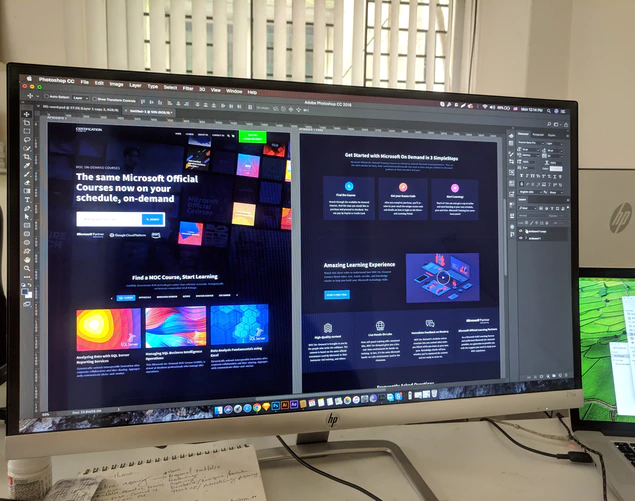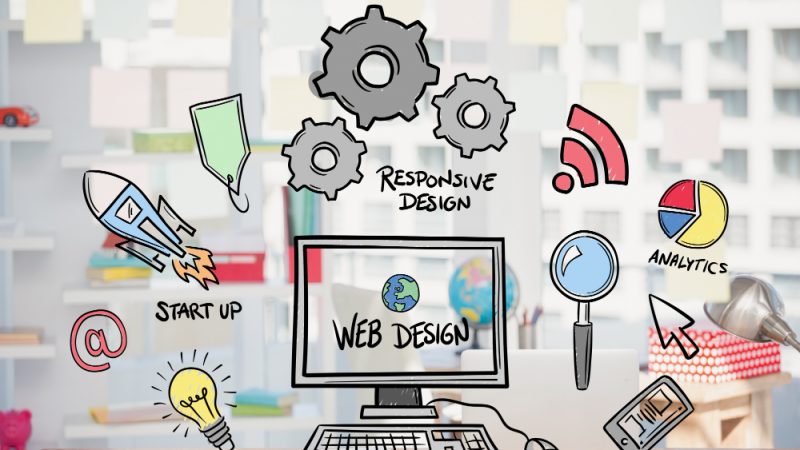Softwares For Web Design – The Top 10 Reviewed

Introduction
With a gargantuan eruption of technological developments in the last five odd decades, the tech industry has taken hold of trade and commerce, shifting almost all the physical businesses on the internet. To establish and then sustain a stronghold in the cloud market, a business, today, needs a well-functioning, user-friendly and easily accessible digital store, i.e. its website, irrespective of its size.
However, not every business person has an in-depth knowledge about technical know-how of such “websites”. But as vast as the internet is, we have a tool to fill-in for this gap of technical know-how as well and that is, “Web Design Softwares”.
Web Design Software has evolved a lot over the last two decades. From text-based pages with hyperlinks in 1991, web-designing has risen to HTML 5, Bootstrap, mobile-first websites, and full-blown content engagements.
Now, don’t get intimidated by these technical jargons. In simple words, these are different versions of websites or you can say an evolution of websites since its inception.
As a result, if you’re wanting to build a website today, there are a variety of options available to you. It all boils down to your coding skills and the functionality your website requires. To ensure that your work runs easily and efficiently, you’ll need the greatest web design software available.
What are Web Design Softwares?
Users with little to no coding experience can utilise web design software to develop dynamic websites instead of relying on web designers. One-stop shops that provide tools to engineer, construct, and maintain websites are the greatest website design software options.
The design parts of these tools are the most robust because they focus on generating beautiful and responsive websites. These programmes will also publish your site to the domain of your choice, allowing you to make changes as needed.
Because there are so many various handheld devices for surfing the web, websites must be dynamic and versatile, which can be challenging to create. The best aspect is that the personalised product often results in websites that are more attractive and unique.
A well-designed piece of software may provide a small business owner complete control over their website, which is beneficial for making quick changes. However, because most of these products do not supply hosting, you will need to protect it before putting your company’s website to the internet.
Site 1: Wix
About the site
Wix is a website builder rather than a coding platform, but it is one of the most popular online website builders, with a variety of plans and products to choose from.
This web builder has a fantastic intuitive design, and with the availability of customisations and tonnes of stunning straight-out-of-the-box templates on offer, it’s a great website builder for people of all skill levels.
Highlights:
- A drag-and-drop website builder is included.
- Wix Editor gives you access to 500 professionally designed templates.
- You can either upload your own fonts or choose from over 100 pre-installed fonts.
- It has complex design capabilities such as animation, video backdrops, and scroll effects that you may use on your webpages.
Shortcomings:
- Redesigning the website is a demanding task.
- In some ways, its tech support appears to be a little sluggish.
Site 2: Adobe Dreamweaver
About the site
This vector-based programme is compatible with both Mac and Windows (unlike Sketch). It integrates well with other Adobe products like Photoshop and Illustrator, and you can quickly import materials such as Adobe Fonts and Adobe Stock.
There are so many great features, including a ‘Repeat Grid’ for fast designing, auto-animation, voice triggers, good collaboration features, heaps of storage for your design files, an array of plugins, and many connectors with other web services, all with a clean and straightforward interface.
Highlights:
- It has tools for quick and flexible coding
- You will be able to preview the web pages and edit them in real time.
- It includes smooth live view editing, multi-monitor compatibility for Windows, a redesigned and modern user interface, and Git integration.
Shortcomings:
- Beginners may need some time to become familiar with the tool.
- You must be able to code in order to utilise this programme.
Site 3: Weebly
About the site
Weebly is another online content management system (CMS), this time geared for people with little or no technical skills. It also allows users to construct online stores utilising pre-made templates in conjunction with their simple website-building framework.
Although the number of themes available for Weebly is limited, these themes are responsive, meaning they are designed to operate on mobile devices, and they include SEO, analytics, and even a capability for publishing ads directly to Facebook. There is a free plan that allows you to familiarise yourself with the service. Paid options have the ability to connect to your own domain.
Highlights:
- SSL security is provided by Weebly for free.
- With its premium plans, you get limitless storage.
- It has functions such as password security, comprehensive site statistics, and site search, among others.
Shortcomings:
- The drag-and-drop feature on Weebly isn’t great.
- It does not give you the ability to manually restore the website.
Site 4: Webflow
About the site
Webflow provides an online visual editor platform to design, build, and launch websites. It is an American web building platform. It enables you to design custom and modern websites with a visual canvas. It’s visual canvas lets you control CSS3, HTML5, and JavaScript and translate semantic code into customized websites.
It can provide the features of enterprise-grade scalability, security, and support. If integrated with marketing tools and collecting from data & storing backups, it can be a complete platform.
Highlights:
- You can use any font using this tool.
- Everything from tracking to line-height can be changed.
- You’ll be able to make interactive animations and deep interactions.
- It has an easy-to-use editor, so even clients and coworkers may make changes.
Shortcomings:
- It doesn’t have a phone number or a live chat option.
Site 5: Squarespace
About the site
Squarespace is a one-stop shop for web designers looking to create professional websites, e-commerce storefronts, or portfolios. It offers top-of-the-line site designs that you can quickly alter to match your specific creative and professional needs.
Entrepreneurs, photographers, restaurants, small enterprises, and other types of businesses can benefit from Squarespace. It’s a one-stop shop for everything. You can also optimize your site for mobile view, quite easily.
Highlights:
- Web pages can have an endless number of sections.
- Team members can collaborate more effectively through its tools.
- Designer colour palettes are available for increased and distinctive personalization.
Shortcomings:
- You’ll need to familiarise yourself with the tool before you can modify your website with drag-and-drop capabilities.
- Because there is no app store, you must rely solely on the system’s built-in functionality.
Site 6: GIMP
About the site
GIMP stands for GNU Image Manipulation Program. It’s a free and open-source image editing programme. It can do image retouching and editing, free-form drawing, and conversion between different image formats, among other things. Windows, Mac OS X, Linux, Sun OpenSolaris, and FreeBSD are all supported.
Create icons, graphical design elements, and graphics for user interface components and mockups with this programme. GIMP allows you to make modifications to the source code and distribute them.
Highlights:
- GIMP supports C, C++, Perl, Python, Schema, and more programming languages.
- It offers excellent colour management capabilities, ensuring high-fidelity colour reproduction on both digital and printed media.
Shortcomings:
- The user interface is a little disorganised.
Site 7: Bootstrap Studio
About the site
Bootstrap Studio is a web design and development tool that lets you create mobile-responsive web pages with drag-and-drop capabilities and configurable templates.
It has a straightforward and powerful user interface that makes web design and prototyping a breeze. It comes with a variety of attractive and mobile-responsive themes that you may personalise to create a unique website.
Highlights:
- Use cards to quickly create a bespoke pricing page.
- It has a fixed sidebar and navigation bar on its dashboard.
- With its single page themes, you can quickly create stylish and engaging home pages.
Shortcomings:
- It is necessary to improve documentation and support.
Site 8: Sketch
About the site
Sketch is a digital design toolkit for macOS that is mostly used for website and mobile app UX and UI design. It may be used to create, prototype, collaborate, and turn ideas into fantastic products.
It has strong vector-editing capabilities and boolean operations to let you create pixel-perfect drawings without causing any damage. You may modify layers to perfection or zoom in at pixel-level to align objects with Smart and Snapping guides.
Highlights:
- The Felipe plugin allows you to turn wireframes into UI elements.
- All design components will be easier to build, change, and share with your team.
- The programme will allow you to add faces, names, and places to actual and diverse data sets.
Shortcomings:
- The utility is not ideal for older machines because it can cause them to slow down.
- Pixelation and distortion might result from cloud sharing.
![]()
Site 9: WordPress
About the site
WordPress is a free and open-source web building platform that comes with all the tools you’ll need to create a dynamic website. WordPress offers a large number of free themes for site customization. It also provides SEO tools, Simple Payments, and Recurring Payments, among other marketing and monetization tools.
You can also use its apps for iOS, Android, Windows, Mac, and Linux to update your websites on the move. It also has a multi-tier user control system to ensure that all users are only making changes that they are authorised to do.
Highlights:
- It offers email and live chat support.
- It provides functionalities for advanced design customization.
- With the premium plan, you will get access to unlimited premium themes.
- It provides storage space ranging from 3 GB to 200 GB as per the plan.
Shortcomings:
- There isn’t a drag-and-drop website builder built-in.
Site 10: Google Web Designer
About the site
Google Web Designer is a tool that allows you to develop HTML-5-based web pages that are interesting. It allows you to create compelling web pages by incorporating interactive features and animation. Google Web Designer works with Google Drive, Google Ads, and Display & Video 360, among other services.
Furthermore, with a comprehensive design suite and the ability to edit CSS, Javascript, and HTML, it concurrently designs and develops your site. You may also move between the Design and Technical Code views to see a live preview of the design.
Highlights:
- It has tools for producing and modifying three-dimensional information.
- Different components, such as video players, maps, and image galleries, can be dragged and dropped.
- It includes features that allow your creative to respond to user activities such as touch, rotation, and shaking.
- Multiple scenes can be added to projects by generating multiple pages. This will provide a unique experience for your viewers.
Shortcomings:
- The text content generation options in Google Web Designer are not available.
- Other web design programmes may not be able to access HTML files made with them.
Conclusion
Free-form web design and development tools are frequently aimed at more experienced web designers and developers. All of these tools, in their own way, can assist you in creating a nice-looking website.
However, not all of them are capable of meeting the exact design specifications. As a result, it’s critical to compare their features and USPs to choose which product will best suit your needs.
Author Bio
Hetvi works as a Product Associate at Refrens.com – Online Invoice Generator & India’s most powerful platform for freelancer’s growth. She has worked for some renowned companies as a Brand and Digital marketing associate. You can follow Refrens.com on Twitter, LinkedIn and Instagram.

![Why Contrast in Design Makes Your Website More User-Friendly [Expert Guide] 4 Why Contrast in Design Makes Your Website More User-Friendly [Expert Guide]](https://technonguide.com/wp-content/uploads/2025/06/Website-800x450.jpg)




